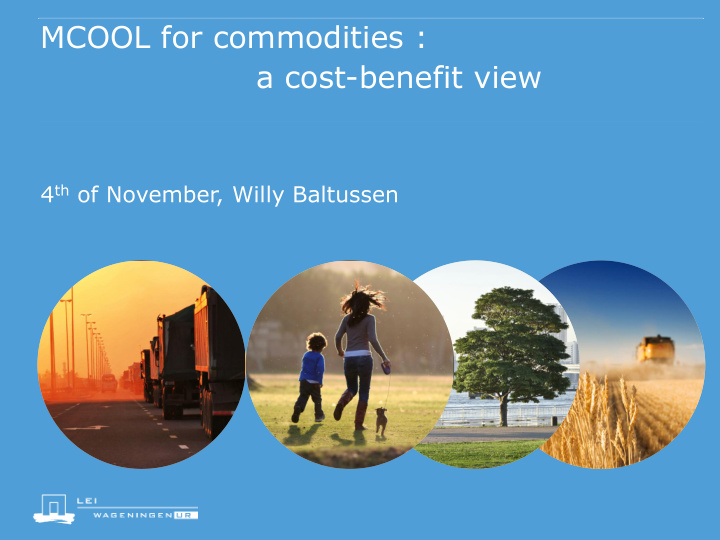



MCOOL for commodities : a cost-benefit view 4 th of November, Willy Baltussen
Commodities With commodities we mean: ● Sugar ● Flour; ● Cocoa; ● Starch ● Vegetable oil and fats ● Vegetable protein In this presentation no distinction is made among these products although differences exists.
Possible benefits (1) ● Consumers have a strong interest in the origin of the products especially meat (93%: FCEC consumer survey, 2013); ● The interest in the origin of the products is far lower for processed products (76% for cereal products: FCEC consumer survey, 2013); ● The added value for consumers increases with the detail of the information: origin per country adds more than EU versus non-EU;
Possible benefits (2) The willingness to pay for this information even for meat seems low (often stated as the consumer paradox); see Special Eurobarometer 410 (2013); DG SANCO study on voluntary labelling (2013); FCEC (2013); LEI (2012)). Consumers rank geographical origin number five after price, appearance, quality use by date and brand. The expected change in buyer behaviour (revealed) is lower than the stated behaviour.
Possible additional costs (1) Following costs are likely to increase in case of MCOOL for commodities: a. Storage; separate per origin; b. Transport costs; separate per origin; c. Cleaning costs to prevent mixing of different origins; d. Increased waste; e. ICT costs; f. Labelling costs (more labels and changing labels);
Possible additional costs (2) Cost increase for commodities of MCOOL depends on: ● Level of detail : MCOOL per country or per trading block (e.g. EU versus non-EU); ● Number of processing steps; more steps equals more costs for labelling the origin; ● B2B products or B2C products? For many commodities both food chains are supplied. ● Part of the production that is international traded and/ or traded between EU Member States.
The balance of costs and benefits The expected increase of benefits is not likely to outweigh the expected increase of costs because: ● Expected willingness to pay for detailed origin information is low; ● Expected cost increase is high for supply chains which are organised in such a way to efficiently supply consumers.
Some final remarks Consumers and consumer organisations think that costs to put origin information on the labels is without any costs (only ink for printing). For almost all food supply chains this assumption doesn’t hold. Origin information is not a free lunch. In the end the consumer will pay most of the additional costs for putting this info on the label. Small cost increases (1 to 3% of wholesaler prices) can have huge impacts on the profitability of firms in the food supply chains because the margins are often less than 3%.
In Summary Demand Benefits: more info more choice Costs : higher price Price Consumer price increases Supply Producer prices decreases Benefits: no costs for supply chains having voluntary origin labelling Costs : increased production costs changing competition
Questions?
Recommend
More recommend